Sinematografi ve Yapımcılık Üzerine
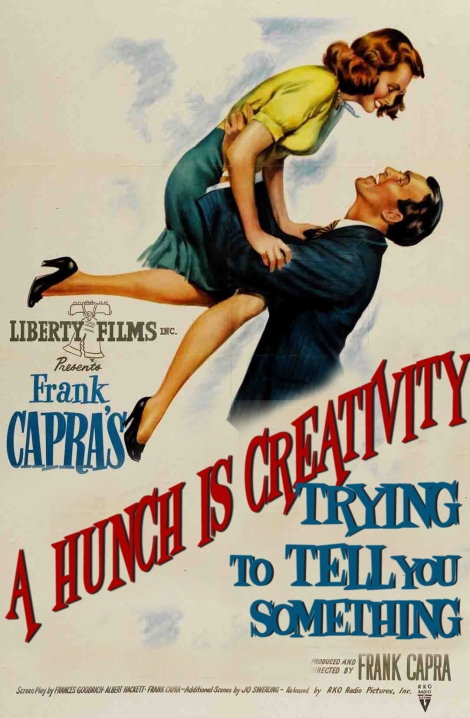
A hunch is creativity trying to tell you something – Frank Capra
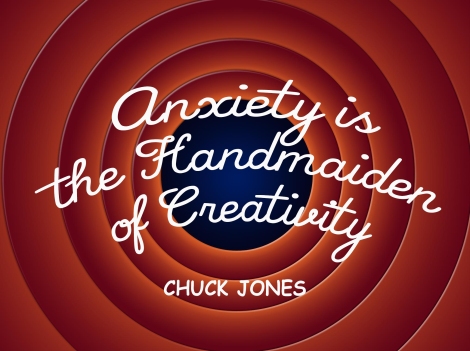
Anxiety is the handmaiden of creativity – Chuck Jones
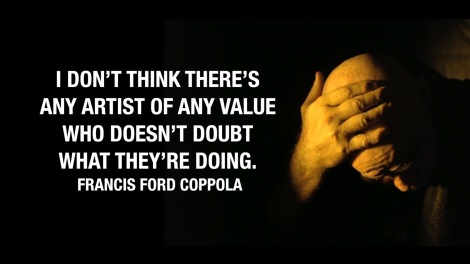
I don’t think there’s any artist of any value who doesn’t doubt what they’re doing. – Francis Ford Coppola
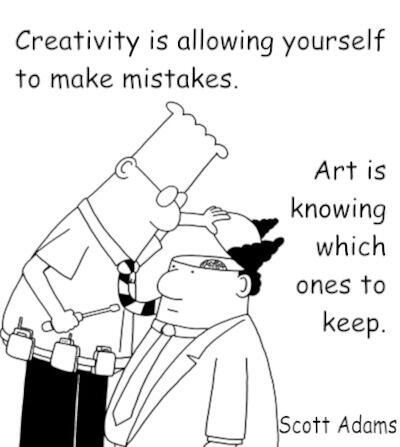
Creativity is allowing yourself to make mistakes. Art is knowing which ones to keep. – Scott Adams
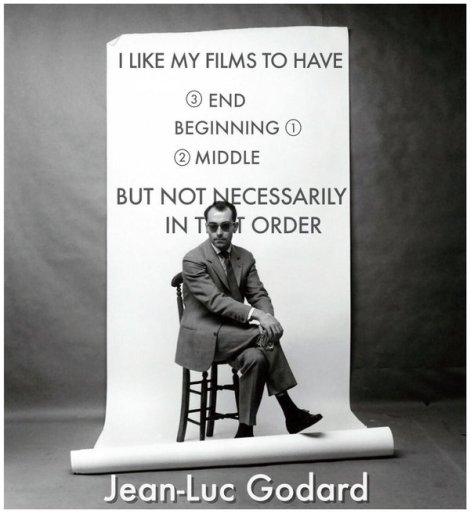
I like my filma to have beginning, a middle and an end… but not necessarily in that order. – Jean-Luc Godard
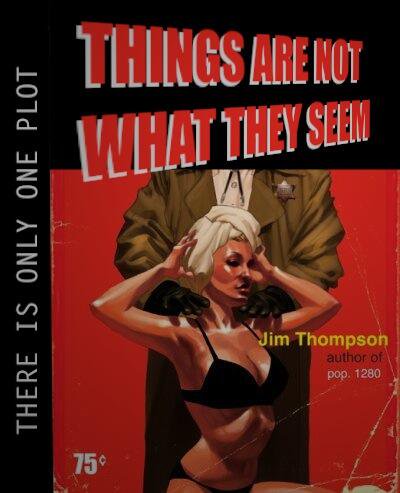
There is only one plot: Things are not what they seem. – Jim Thompson
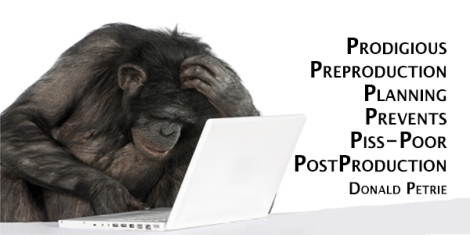 Prodigious Preproduction Planning Prevents Piss-Poor Postproduction. – Ronald Petrie
Prodigious Preproduction Planning Prevents Piss-Poor Postproduction. – Ronald Petrie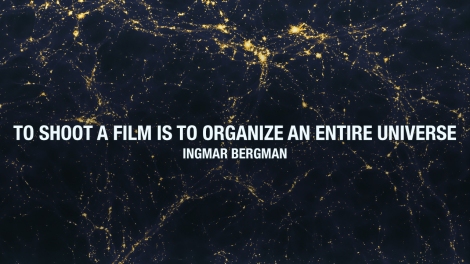
To shoot a film is to organize an entire universe. – Ingmar Bergman
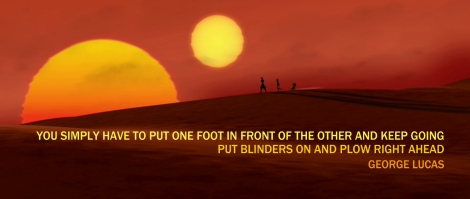
You simply have to put one foot in front of the other and keep going. Put blinders on and plow right ahead. – George Lucas
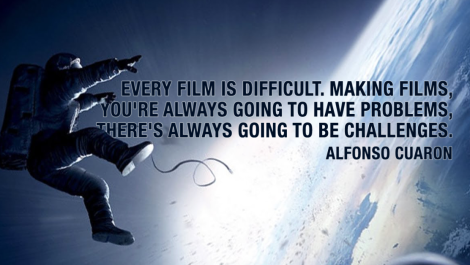
Every film is difficult. Making films, you’re always going to have problems, there’s always going to be challenges. – Alfonso Cuaron
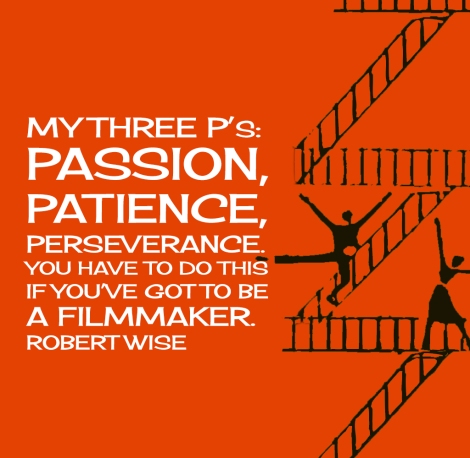
My three Ps: passion, patience, perseverance. You have to do this if you’ve got to be a filmmaker. – Robert Wise

The only safe thing to do is to take a chance. – Mike Nichols
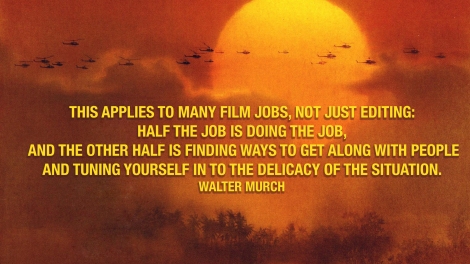
This applies to many film jobs, not just editing: half the job is doing the job, and the other half is finding ways to get along with people and tuning yourself in to the delicacy of the situation. – Walter Murch
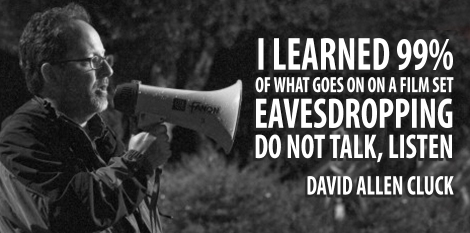
I learned 99% of what goes on on a Film set eavesdropping. Do not talk, listen. – David Allen Cluck
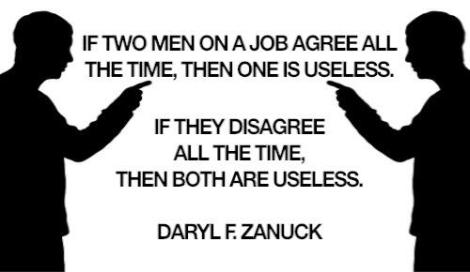
If two men on a job agree al the time, then one is useless. If they disagree all the time then both are useless. – Daryl F. Zanuck
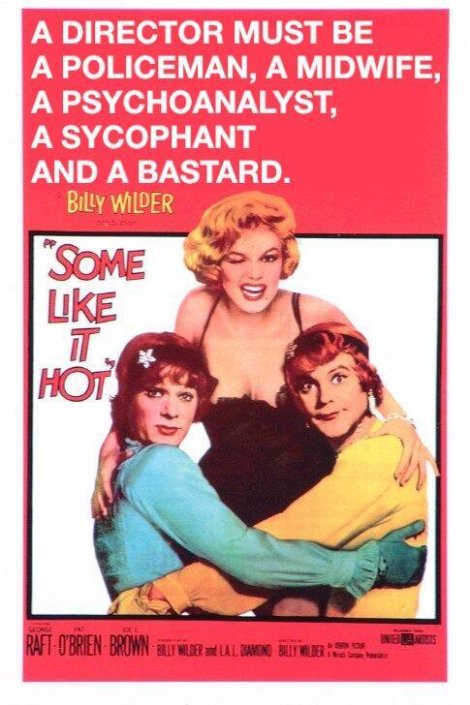
A director must be a policeman, a midwife, a psychoanalyst, a sycophant and a bastard. – Billy Wider
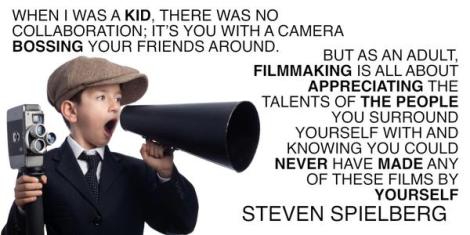
When I was a kid, there was no collaboration: it’s you with a camera bossing your friends around. But as an adult, filmmaking is all about appreciating the talents of the people you surround yourself with and knowing you could never have made any of these films by yourself. – Steven Spielberg.
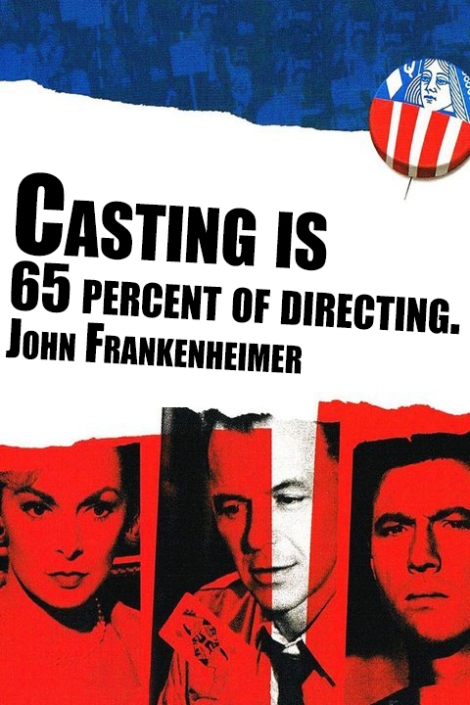
Casting is 65 percent of directing – John Frankenheimer
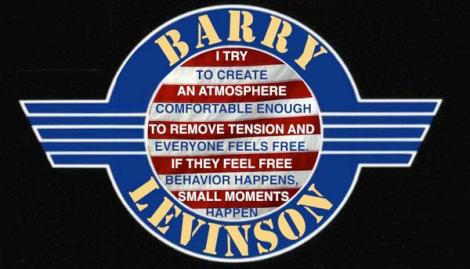
I try to create an atmosphere comfortable enough to remove tension and everyone feels free. If they feel free, behaviour happens, small moments happen. – Barry Levinson
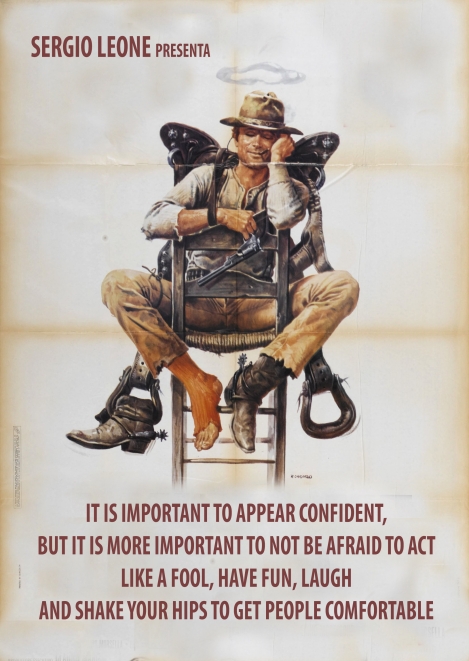
It is important to appear confident, but it is more important to not be afraid to act like a fool, have fun, laugh and shake your hips to get people comfortable. – Sergio Leone
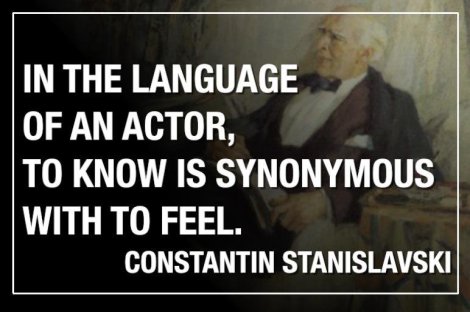
In the language of the actor, to know is synonymous with to feel. – Constantin Stanislavsky
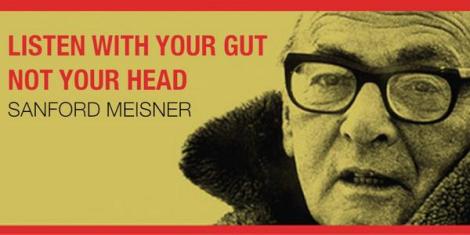
Listen with your gut, not your head. – Sanford Meisner
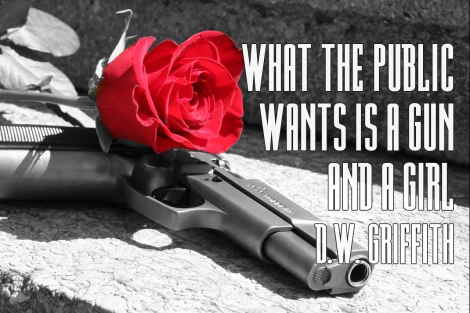
What the public wants is a gun and a girl – D.W. Griffith
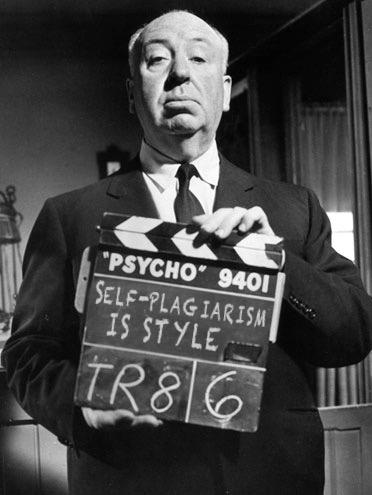
Self-plagiarism is style – Alfred Hitchcock
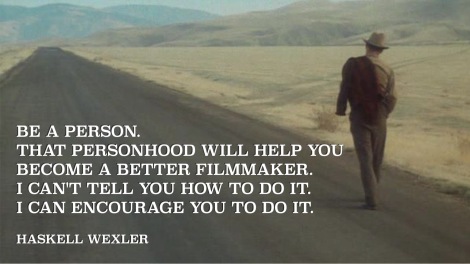
Be a person. That personhood will help you become a better filmmaker. I can’t tell you how to do it. I can encourage you to do it. – Haskell Wexler
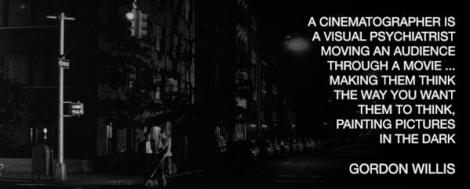
A Cinematographer is a visual psychiatrist moving an audience through a movie… making them think the way you want them to think, painting pictures in the dark. – Gordon Willis
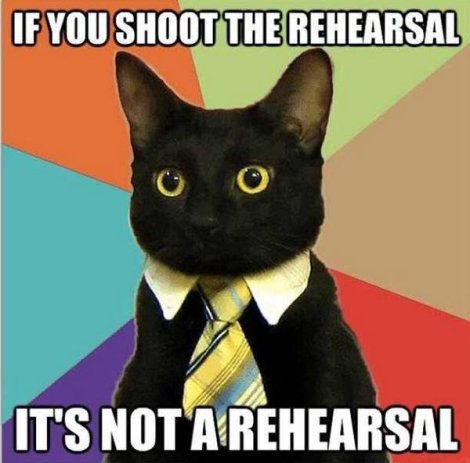
If you shoot the rehearsal, it’s not a rehearsal. – Larry Fong
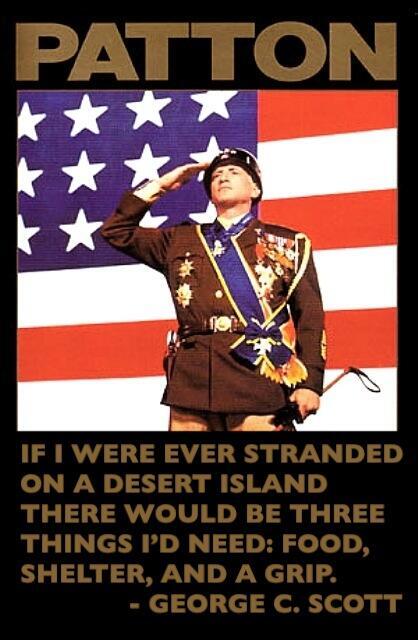
If i were ever stranded on a desert island there would be three things I’d need: food, shelter and a grip. – George C. Scott
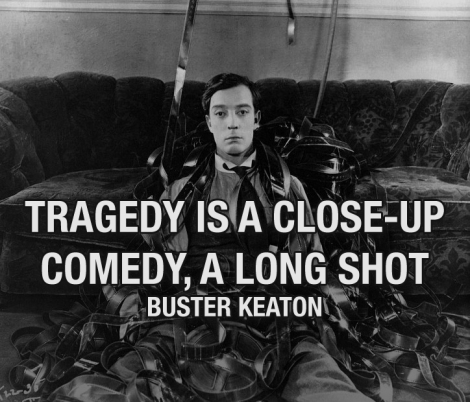
Tragedy is a close-up; comedy, a long shot. – Buster Keaton
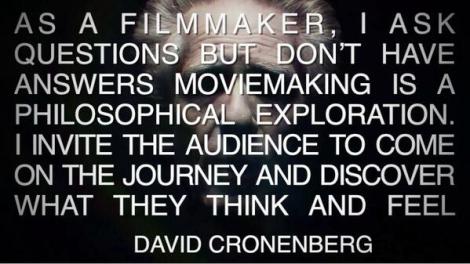
As a filmmaker, I ask question but don’t have answers. Moviemaking is a philosophical exploration. I invite the audience to come on the journey and discover what they think and feel – David Cronenberg
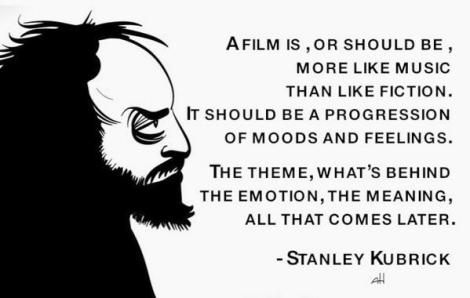
A film is, or should be, more like music than like fiction. It should be a progression of moods and feelings. The theme, what’s the emotion, the meaning, all that comes later. -Stanley Kubrick
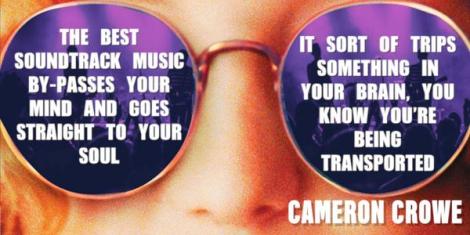
The best soundtrack music by-passes your mind and goes straight to your soul. It sort of trips something in your brain, you know you’re being transported. – Cameron Crowe
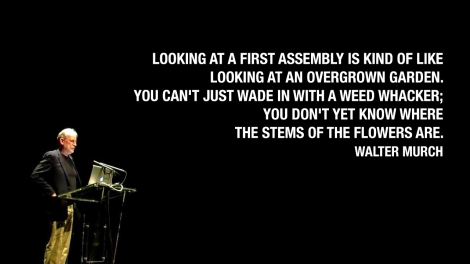
Looking at a first assembly is kind of like looking at an overgrown garden. You can’t just wade in with a weed whacker; you don’t yet know where the stems of the flowers are. – Walter Murch
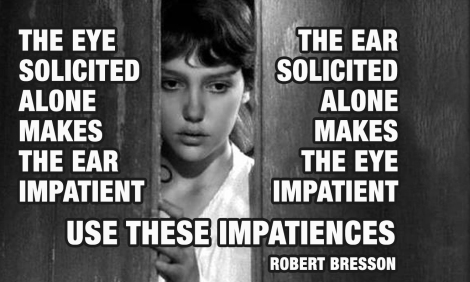
The eye solicited alone makes the ear impatient, the ear solicited alone makes the eye impatient. Use these impatiences. – Robert Bresson
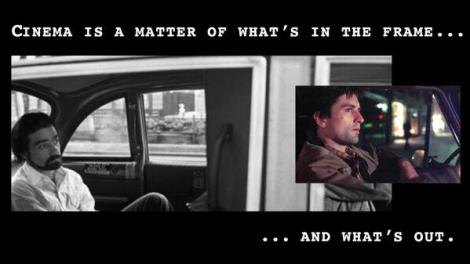
Cinema is a matter of what’s in the frame and what’s out. – Martin Scorsese
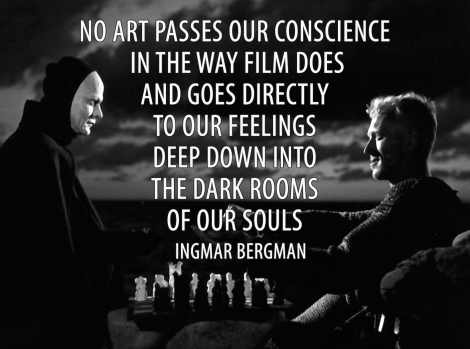
No art passes our conscience in the way film does, and goes directly to our feelings, deep down into the dark rooms of our souls. – Ingmar Bergman
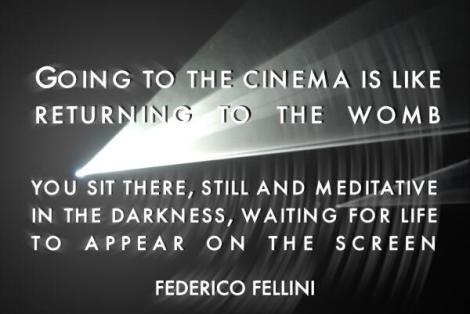
Going to the cinema is like retuning to the womb. You sit there, still and meditative in the darkness, waiting for life to appear on the screen. – Federico Fellini
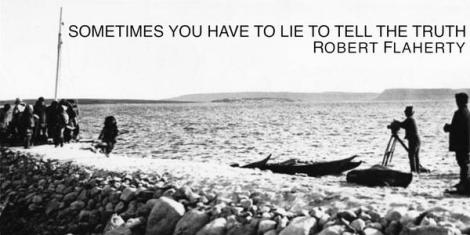
Sometimes you have to lie to tell the truth – Robert Flaherty
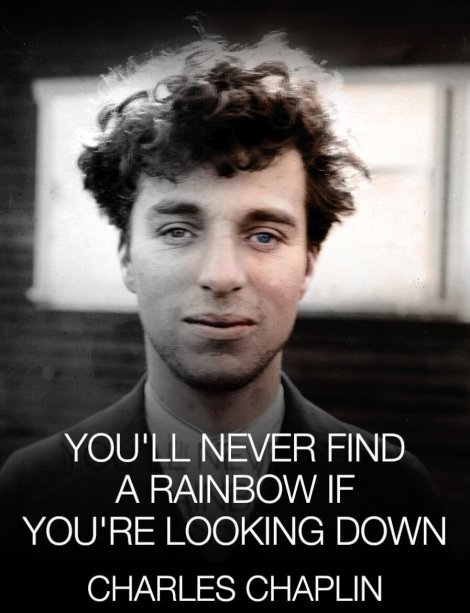
You’ll never find a rainbow if you’re looking down – Charles Chaplin
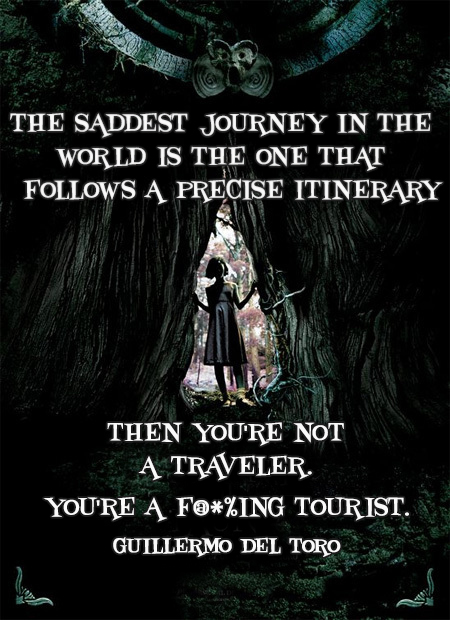
The saddest journey in the world is the one that follows a precise itinerary. Then you’re not a traveler. You’re a f@*%ing tourist. – Guillermo del Toro
 It’s not what you light that counts, but what you do not light.
It’s not what you light that counts, but what you do not light.
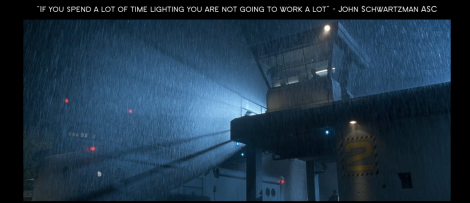 If you spend a lot of time lighting you are not going to work a lot.
If you spend a lot of time lighting you are not going to work a lot.
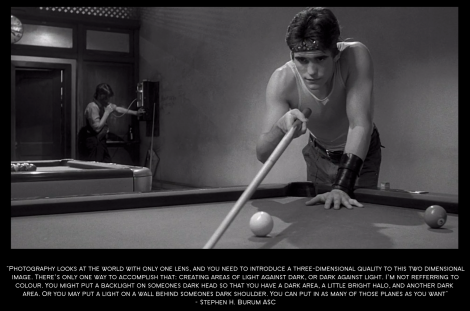 Photography looks ta the world with only one lens, an you need to introduce a three-dimensional quality to this two-dimensional image. There’s only one way to accomplish that. Creating areas of light against dark, or dark against light. I’m not referring to colour. You might put a backlight on someones dark head so that you have a dark area, a little bright halo, and another dark area. Or you may put a light on a wall behind someone dark shoulders. You can put in as many of this planes as you want.
Photography looks ta the world with only one lens, an you need to introduce a three-dimensional quality to this two-dimensional image. There’s only one way to accomplish that. Creating areas of light against dark, or dark against light. I’m not referring to colour. You might put a backlight on someones dark head so that you have a dark area, a little bright halo, and another dark area. Or you may put a light on a wall behind someone dark shoulders. You can put in as many of this planes as you want.
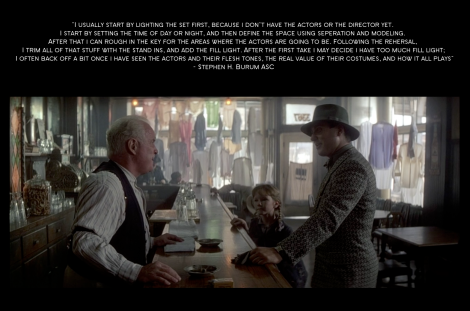 I usually start by lighting the set first because I don’t have the actors or the director yet. I start by setting the time of day or night, and then define the space using separation and modelling. After that I can rough in the key for the areas where the actors are going to be. Following the rehearsal, I trim all of that stuff with the stand ins, and I add the fill light. After the first take, I may decide I have too much fill light. I often back off a bit once I have seen the actors and their flesh tones, the real value of their costumes and how it all plays.
I usually start by lighting the set first because I don’t have the actors or the director yet. I start by setting the time of day or night, and then define the space using separation and modelling. After that I can rough in the key for the areas where the actors are going to be. Following the rehearsal, I trim all of that stuff with the stand ins, and I add the fill light. After the first take, I may decide I have too much fill light. I often back off a bit once I have seen the actors and their flesh tones, the real value of their costumes and how it all plays.
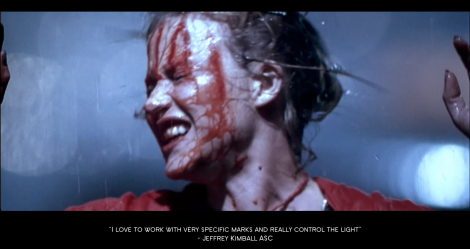 I love to work with very specific marks and really control the light
I love to work with very specific marks and really control the light
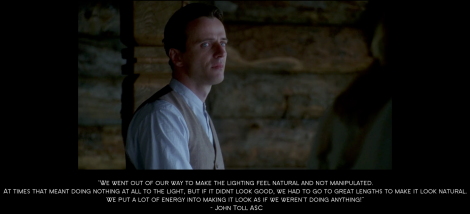 We went out of our way to make the lighting feel natural and not manipulated. At times that meant doing nothing at all to the light. But, if it didn’t look good we had to go to great lengths to make it look natural. We put a lot of energy into making it look as if we weren’t doing anything.
We went out of our way to make the lighting feel natural and not manipulated. At times that meant doing nothing at all to the light. But, if it didn’t look good we had to go to great lengths to make it look natural. We put a lot of energy into making it look as if we weren’t doing anything.
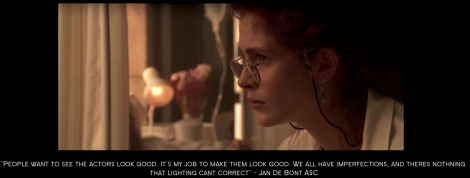 People want to see the actors look good. It’s my job to make them look good. We all have imperfections and there is nothing that lighting can’t correct.
People want to see the actors look good. It’s my job to make them look good. We all have imperfections and there is nothing that lighting can’t correct.
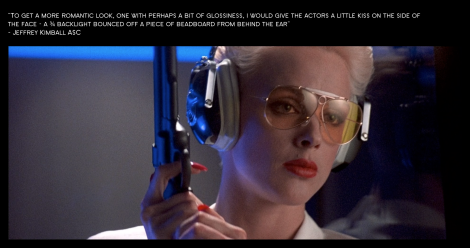 To get a more romantic look, one with perhaps a bit of glossiness, I would give the actors a little kiss on the side of the face – a 1/4 backlight bounced off a piece of beadboard from behind that ear.
To get a more romantic look, one with perhaps a bit of glossiness, I would give the actors a little kiss on the side of the face – a 1/4 backlight bounced off a piece of beadboard from behind that ear.
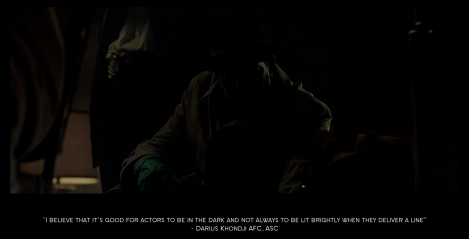 I believe that it’s good for actors to be in the dark and not always to be lit brightly when they deliver a line.
I believe that it’s good for actors to be in the dark and not always to be lit brightly when they deliver a line.
 I find the source of light for each shot and build on that. You get an artistic buzz from it. But a lot of the time it’s just working at it and doing your job.
I find the source of light for each shot and build on that. You get an artistic buzz from it. But a lot of the time it’s just working at it and doing your job.
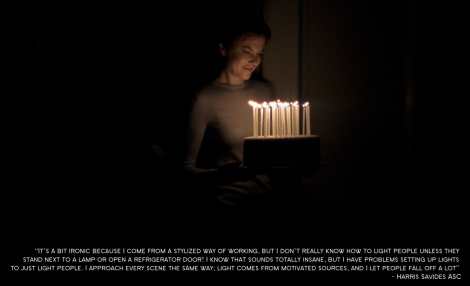 It’s a bit ironic because I come from a stylised way of working but I don’t really know how to light people unless they stand next to a lamp or open a refrigerator door. I know that sounds totally insane. But, I have problems setting up lights to just light people. I approach every scene in the same way. Light comes from motivated sources and I let people fall off a lot.
It’s a bit ironic because I come from a stylised way of working but I don’t really know how to light people unless they stand next to a lamp or open a refrigerator door. I know that sounds totally insane. But, I have problems setting up lights to just light people. I approach every scene in the same way. Light comes from motivated sources and I let people fall off a lot.
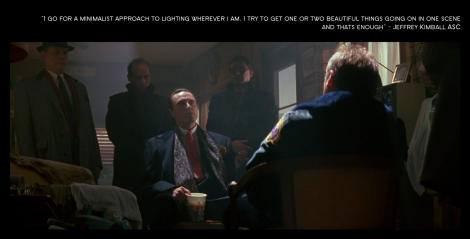 I go for minimalist approach to lighting wherever I am. I try to get one or two beautiful things going on in scene and that’s enough.
I go for minimalist approach to lighting wherever I am. I try to get one or two beautiful things going on in scene and that’s enough.
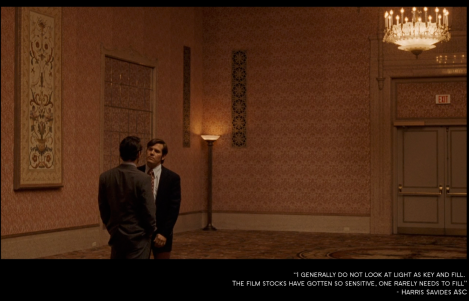 I generally do not look at light as key and fill. The film stock have gotten so sensitive, one rarely needs to fill.
I generally do not look at light as key and fill. The film stock have gotten so sensitive, one rarely needs to fill.
 For me, contrast is like another character in the film – a role which is played by the cinematography
For me, contrast is like another character in the film – a role which is played by the cinematography
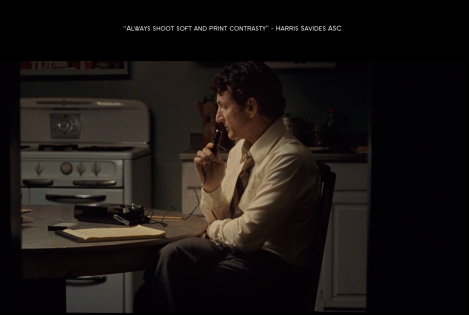 Always shoot soft and print contrasty. –
Always shoot soft and print contrasty. –
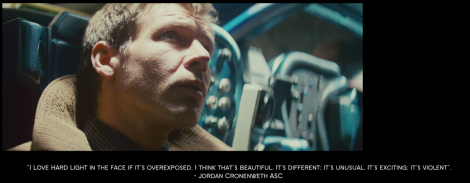 I love hard light in the face if it is overexposed. I think that’s beautiful. It’s different. It’s unusual. It’s exciting. It’s violent.
I love hard light in the face if it is overexposed. I think that’s beautiful. It’s different. It’s unusual. It’s exciting. It’s violent.
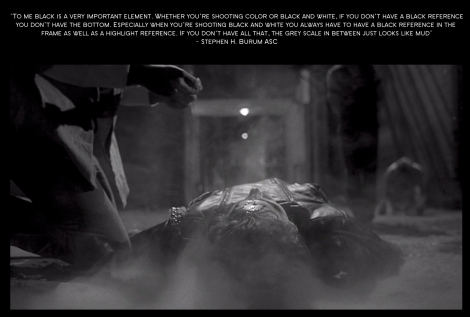 To me black is a very important element. Whether you’re shooting color or black and white. If you don’t have a black reference you don’t have the bottom . Especially when you are shooting black and white, you always have to have a black reference. In the frame as well as highlight reference. If you don’t have all that the grey scale in between just looks like mud.
To me black is a very important element. Whether you’re shooting color or black and white. If you don’t have a black reference you don’t have the bottom . Especially when you are shooting black and white, you always have to have a black reference. In the frame as well as highlight reference. If you don’t have all that the grey scale in between just looks like mud.
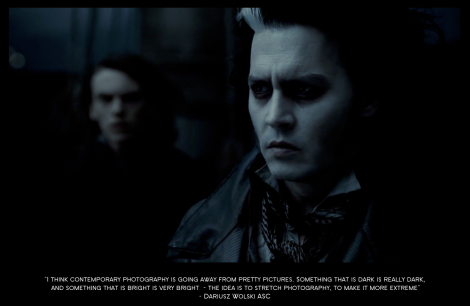 I think contemporary photography is going away from pretty pictures. Something that is dark is really dark, and something that is bright is very bright – the idea is to stretch photography, to make it more extreme.
I think contemporary photography is going away from pretty pictures. Something that is dark is really dark, and something that is bright is very bright – the idea is to stretch photography, to make it more extreme.
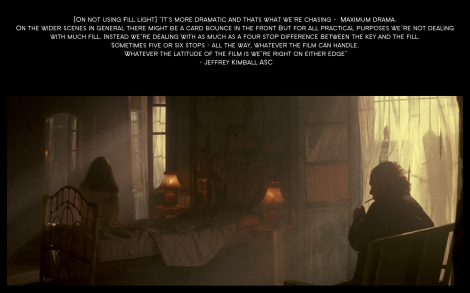 [On not using fill light] It’s more dramatic and that’s what we’re chasing – maximum drama. On the wider scene in general there might be a card bounce in the front but for all practical purpose we’re not dealing with much fill. Instead we dealing with a much as four stop difference between the key in the fill, sometimes five or six stops – all the way. Whatever this film can handle, whatever the latitude of the film is, we’re right on either edge.
[On not using fill light] It’s more dramatic and that’s what we’re chasing – maximum drama. On the wider scene in general there might be a card bounce in the front but for all practical purpose we’re not dealing with much fill. Instead we dealing with a much as four stop difference between the key in the fill, sometimes five or six stops – all the way. Whatever this film can handle, whatever the latitude of the film is, we’re right on either edge.
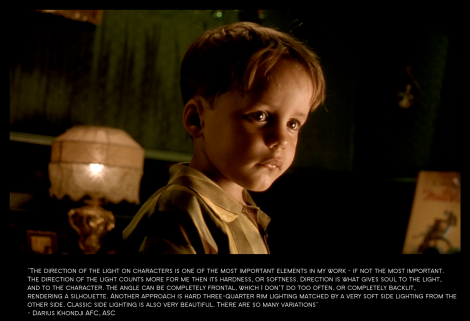 The direction of the light on characters is one of the most important elements in my work – if not the most important. The directon of the light counts more for me than its hardness or softness. Direction is what gives soul to the light and to the character. The angle can be completely frontal, which I don’t do too often, or completely backlit, rendering a silhouette. Another approach is hard three-quarter rim lighting match by a very soft side lighting from the other side. Classic side lighting is also very beautiful. There are so many variations.
The direction of the light on characters is one of the most important elements in my work – if not the most important. The directon of the light counts more for me than its hardness or softness. Direction is what gives soul to the light and to the character. The angle can be completely frontal, which I don’t do too often, or completely backlit, rendering a silhouette. Another approach is hard three-quarter rim lighting match by a very soft side lighting from the other side. Classic side lighting is also very beautiful. There are so many variations.
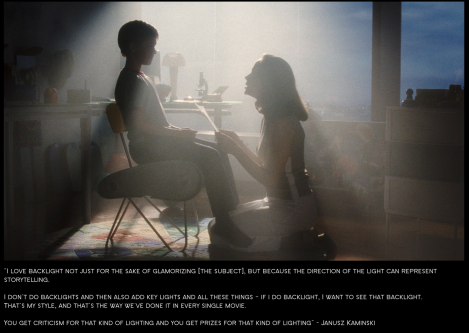 I love backlighting not just for the sake of glamourising [the subject] but because the direction of the light can represent storytelling. I don’t do backlights and then also adds key lights and all these things – if I do backlight I want to see that backlight. That’s my style, and that’s the way we have done it in every single movie. You get criticism for the kind of lighting and you get prizes for that kind of lighting.
I love backlighting not just for the sake of glamourising [the subject] but because the direction of the light can represent storytelling. I don’t do backlights and then also adds key lights and all these things – if I do backlight I want to see that backlight. That’s my style, and that’s the way we have done it in every single movie. You get criticism for the kind of lighting and you get prizes for that kind of lighting.
 I can never use enough backlighting is it’s just that some director want to see the actors faces I keep telling them that the audience only goes to see sex.
I can never use enough backlighting is it’s just that some director want to see the actors faces I keep telling them that the audience only goes to see sex.
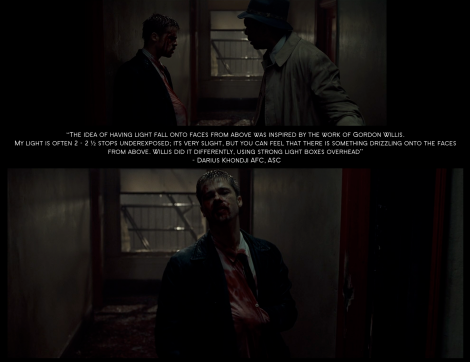 The idea of having light fall onto faces from above was inspired by the work of Gordon Willis. My light is often 2 or 2 1/2 stops underexposed. It’s very slight, and you can feel that there is something drizzling on to the faces from above. Willis did it differently – using strong light boxes overhead.
The idea of having light fall onto faces from above was inspired by the work of Gordon Willis. My light is often 2 or 2 1/2 stops underexposed. It’s very slight, and you can feel that there is something drizzling on to the faces from above. Willis did it differently – using strong light boxes overhead.
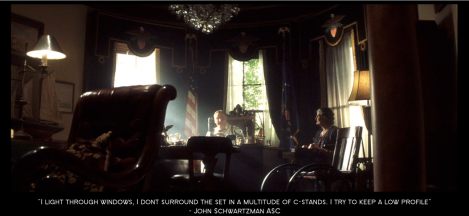 I light through windows. I don’t surround the set in a multitude of C-stands. I try to keep a low profile.
I light through windows. I don’t surround the set in a multitude of C-stands. I try to keep a low profile.
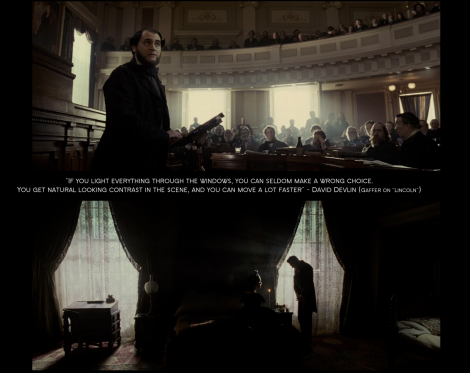 If you light everything through the windows, you can seldom make a wrong choice. You get natural looking contrast in the scene, and you can move a lot faster.
If you light everything through the windows, you can seldom make a wrong choice. You get natural looking contrast in the scene, and you can move a lot faster.
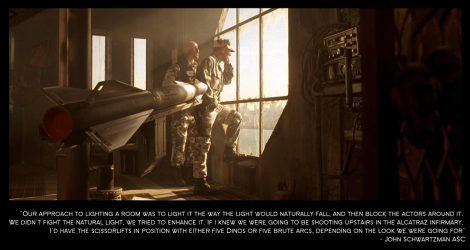 Our approach to lighting the room was to light it the way the light would naturally fall, and block the actors around it. We didn’t fight the natural light. We tried to enhance it. If I knew we were going to be shooting upstairs in the Alcatraz infirmary, I’d have the scissorlifts in position with either five Dinos or five Brute ARC’s, depending on the look we were going for.
Our approach to lighting the room was to light it the way the light would naturally fall, and block the actors around it. We didn’t fight the natural light. We tried to enhance it. If I knew we were going to be shooting upstairs in the Alcatraz infirmary, I’d have the scissorlifts in position with either five Dinos or five Brute ARC’s, depending on the look we were going for.
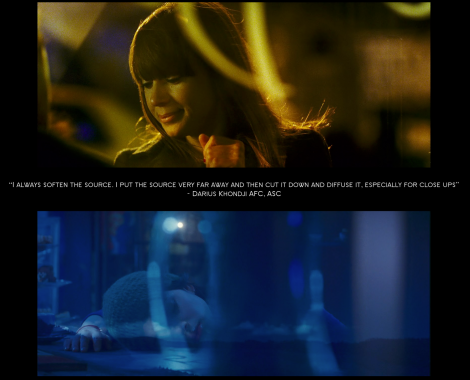 I always soften the source. I put the source very far away and then cut it down and diffuse it, especially for close ups.
I always soften the source. I put the source very far away and then cut it down and diffuse it, especially for close ups.
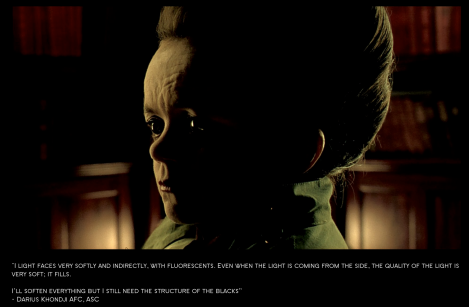 I light faces very softly and indirectly, with fluorescents. Even when the light is coming from the side, the the quality of the light is very soft. it fills. I’ll soften everything but I still need the structure of the blacks.
I light faces very softly and indirectly, with fluorescents. Even when the light is coming from the side, the the quality of the light is very soft. it fills. I’ll soften everything but I still need the structure of the blacks.
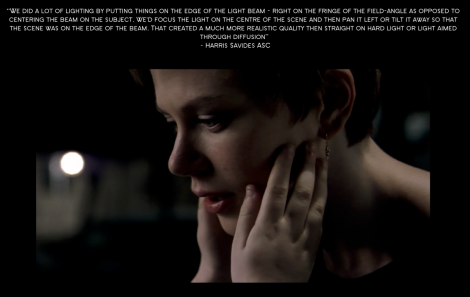 We did a lot of lighting by putting things on the edge of the light beam – right on the fringe of the field-angle as opposed to centring the beam on the subject. We’d focus the light on the centre of the scene and then pan it left or tilt it away so that the scene was on the edge of the beam. That created a much more realistic than straight on hard light or light aimed through diffusion.
We did a lot of lighting by putting things on the edge of the light beam – right on the fringe of the field-angle as opposed to centring the beam on the subject. We’d focus the light on the centre of the scene and then pan it left or tilt it away so that the scene was on the edge of the beam. That created a much more realistic than straight on hard light or light aimed through diffusion.
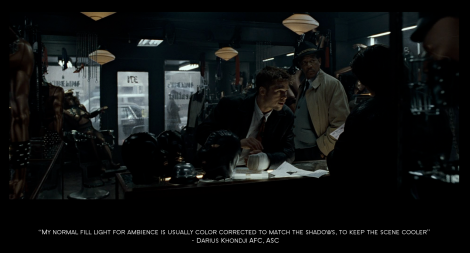 My normal fill light for ambience is usually color corrected to match the shadows, to keep the scene cooler.
My normal fill light for ambience is usually color corrected to match the shadows, to keep the scene cooler.
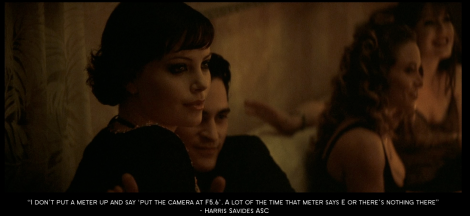 I don’t put a meter up and say ‘put the camera at F5 .6 A lot of the time that meter says E or there is nothing there.
I don’t put a meter up and say ‘put the camera at F5 .6 A lot of the time that meter says E or there is nothing there.
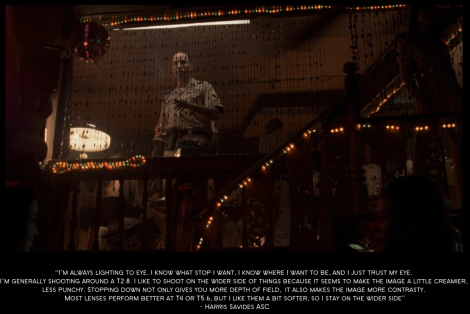 I’m always lighting to eye. I know what stop I want. I know where I want to be and I just trust my eye. I’m generally shooting around a T2 .8. I like to shoot on the wider side of things because it seems to make the image a little creamier, less punchy. Stopping down not only gives you more depth of field, it also makes the image more contrasty. Most lenses perform better at T4 or T5.6, but I like them a bit softer so I stay on the wider side.
I’m always lighting to eye. I know what stop I want. I know where I want to be and I just trust my eye. I’m generally shooting around a T2 .8. I like to shoot on the wider side of things because it seems to make the image a little creamier, less punchy. Stopping down not only gives you more depth of field, it also makes the image more contrasty. Most lenses perform better at T4 or T5.6, but I like them a bit softer so I stay on the wider side.
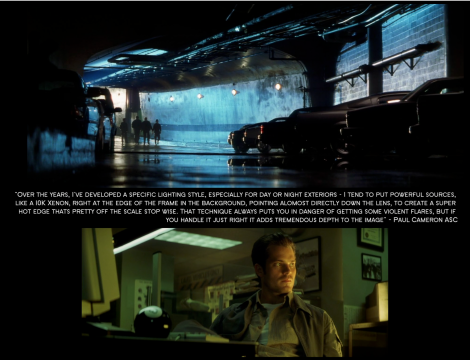 Over the years I’ve developed a specific lighting style, especially for day or night exteriors. I tend to put powerful sources, like a 10 K xenon, right at the edge of the frame in the background, pointing almost directly down the lens, to create a super hot edge that’s pretty off the scale stop wise. That technique always puts you in danger of getting some violent flares but if you handle it just right it adds tremendous depth to the image.
Over the years I’ve developed a specific lighting style, especially for day or night exteriors. I tend to put powerful sources, like a 10 K xenon, right at the edge of the frame in the background, pointing almost directly down the lens, to create a super hot edge that’s pretty off the scale stop wise. That technique always puts you in danger of getting some violent flares but if you handle it just right it adds tremendous depth to the image.
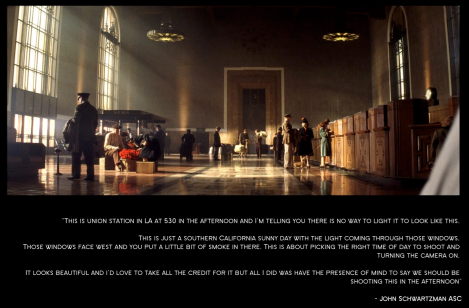 This is Union Station in LA at 5:30 in the afternoon and I’m telling you there is no way to light it to look like this. This is just a Southern California sunny day with the light coming through those windows. Those windows face west you put a little bit of smoke in there. This is about picking the right time of day to shoot in turning the camera on. It looks beautiful and I’d love to take all the credits. But all I did was to have the presence of mind to say we should be shooting there in the afternoon.
This is Union Station in LA at 5:30 in the afternoon and I’m telling you there is no way to light it to look like this. This is just a Southern California sunny day with the light coming through those windows. Those windows face west you put a little bit of smoke in there. This is about picking the right time of day to shoot in turning the camera on. It looks beautiful and I’d love to take all the credits. But all I did was to have the presence of mind to say we should be shooting there in the afternoon.
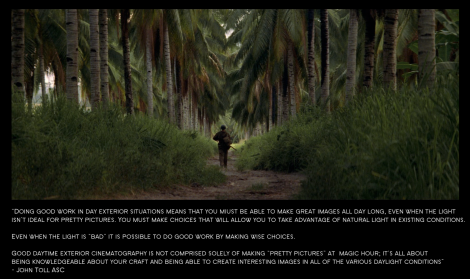 Doing good work in day exterior situation means that you must be able to make great images all day long, even when the light isn’t ideal for pretty pictures. You must make choices that will allow you to take advantage of natural light in existing conditions. Even when the light is that ‘bad’, it is possible to do good work by making wise choices. Good daytime exterior cinematography is not comprised solely of making pretty pictures at magic hour. It’s all about being knowledgeable about your craft and being able to create interesting images in all of the various daylight conditions.
Doing good work in day exterior situation means that you must be able to make great images all day long, even when the light isn’t ideal for pretty pictures. You must make choices that will allow you to take advantage of natural light in existing conditions. Even when the light is that ‘bad’, it is possible to do good work by making wise choices. Good daytime exterior cinematography is not comprised solely of making pretty pictures at magic hour. It’s all about being knowledgeable about your craft and being able to create interesting images in all of the various daylight conditions.
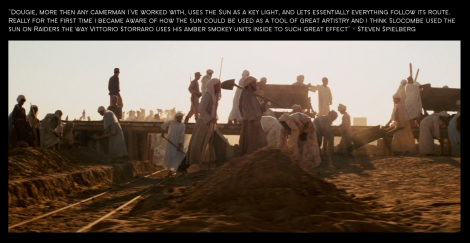 Dougie more than any cameraman I’ve worked with uses the sun as a key light and let’s essentially everything follow its rout. Really for the first time I became aware of how the sun could be used as a tool of great artistry and I think Slocombe used the sun on Raiders the way Vittorio Storraro uses his amber smokey units inside to such great effect.
Dougie more than any cameraman I’ve worked with uses the sun as a key light and let’s essentially everything follow its rout. Really for the first time I became aware of how the sun could be used as a tool of great artistry and I think Slocombe used the sun on Raiders the way Vittorio Storraro uses his amber smokey units inside to such great effect.
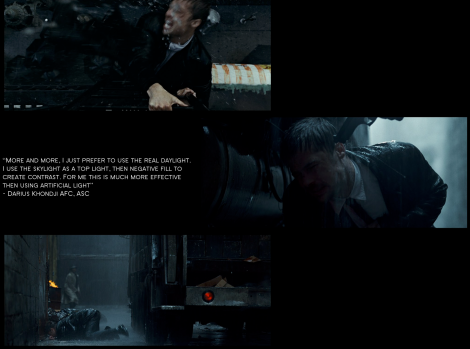 More and more, I just prefer to use the real daylight. I use the skylight as a top light, then negative fill to create contrast. For me this is much more effective than using artificial light.
More and more, I just prefer to use the real daylight. I use the skylight as a top light, then negative fill to create contrast. For me this is much more effective than using artificial light.
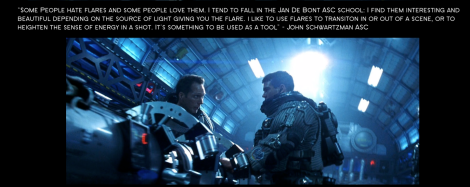 Some people hate flares and some people love them. I tend to fall in the Jan De Bont ASC school. I find them interesting and beautiful depending on the source of light giving you the flare. I like to use flares to transition in or out of a scene, or to heighten the sense of energy in a shot. It’s something to be used as a tool.
Some people hate flares and some people love them. I tend to fall in the Jan De Bont ASC school. I find them interesting and beautiful depending on the source of light giving you the flare. I like to use flares to transition in or out of a scene, or to heighten the sense of energy in a shot. It’s something to be used as a tool.
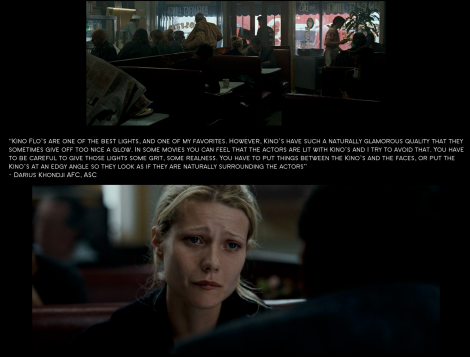 Kino Flo’s are one of the best lights, and one of my favourites. However, Kino’s have such unnaturally glamorous quality that they sometimes give off too nice a glow. In some movies you can feel that the actors are lit with Kino’s and I try to avoid that. You have to be careful to gave those lights grit, some realness. You have to put things between Kino’s and the faces, or put the Kino’s at an edgy angle so they look as if they are naturally surrounding the actors.
Kino Flo’s are one of the best lights, and one of my favourites. However, Kino’s have such unnaturally glamorous quality that they sometimes give off too nice a glow. In some movies you can feel that the actors are lit with Kino’s and I try to avoid that. You have to be careful to gave those lights grit, some realness. You have to put things between Kino’s and the faces, or put the Kino’s at an edgy angle so they look as if they are naturally surrounding the actors.
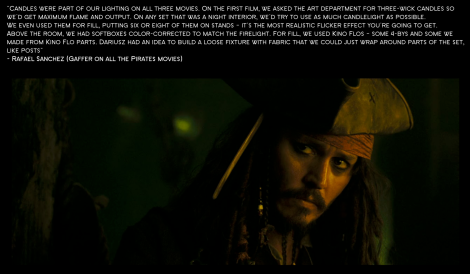 Candles were part of our lighting on all three movies. On the first film we asked the art department for three week candles so we’d get the maximum flame and output. On any set that was a night interior we’d try use as much candlelight as possible. We even use them for fill, putting six or eight of them on stands – it’s the most realistic flicker effect you’re going to get. Above the room, we had soft boxes color corrected to match the firelight for fill. We used Kino Flo’s – some 4-BYs and some we made from Kino Flo parts. Darius had an idea to build a loose fixture with fabric that we could just wrap around parts of the set like posts.
Candles were part of our lighting on all three movies. On the first film we asked the art department for three week candles so we’d get the maximum flame and output. On any set that was a night interior we’d try use as much candlelight as possible. We even use them for fill, putting six or eight of them on stands – it’s the most realistic flicker effect you’re going to get. Above the room, we had soft boxes color corrected to match the firelight for fill. We used Kino Flo’s – some 4-BYs and some we made from Kino Flo parts. Darius had an idea to build a loose fixture with fabric that we could just wrap around parts of the set like posts.
 [Adrian Biddle] uses a faint layer of smoke. He uses a lot of soft light and he gives everything a creamy look. It’s not so much smoky it has a light texture and it’s very nice to look at.
[Adrian Biddle] uses a faint layer of smoke. He uses a lot of soft light and he gives everything a creamy look. It’s not so much smoky it has a light texture and it’s very nice to look at.
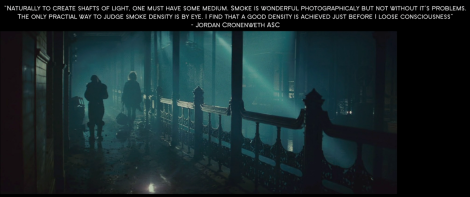 Naturally to create shafts of light one must have some medium. Smoke is wonderful photographically but not without its problems. The only practical way to judge smoke density is by eye. I found a good density is achieved just before I lose consciousness.
Naturally to create shafts of light one must have some medium. Smoke is wonderful photographically but not without its problems. The only practical way to judge smoke density is by eye. I found a good density is achieved just before I lose consciousness.
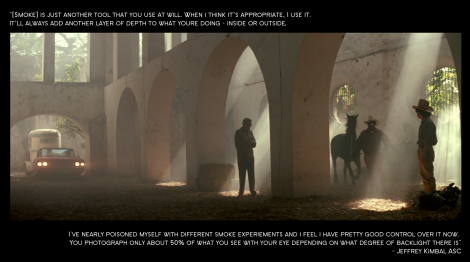 Smoke is just another tool that you use at will. When I think it’s appropriate, I use it. It’ll always add another layer of depth to what you’re doing, inside or outside. I have nearly poisoned myself with different smoke experiments and I feel I have pretty good control over now. You photograph only about 50% of what you see with your eyes depending on what degree of backlight there is.
Smoke is just another tool that you use at will. When I think it’s appropriate, I use it. It’ll always add another layer of depth to what you’re doing, inside or outside. I have nearly poisoned myself with different smoke experiments and I feel I have pretty good control over now. You photograph only about 50% of what you see with your eyes depending on what degree of backlight there is.
Lighting is your brush. ‘A cinematographer has to design and write a story, starting at the beginning, through the evolution to the end. That’s why I consider my profession is as a writer of light.’ –Vittorio Storaro
 It’s not what you light that counts, but what you do not light.
It’s not what you light that counts, but what you do not light.
– Jordan Cronenweth ASC
 If you spend a lot of time lighting you are not going to work a lot.
If you spend a lot of time lighting you are not going to work a lot.
– John Shwartzman ASC
 Photography looks ta the world with only one lens, an you need to introduce a three-dimensional quality to this two-dimensional image. There’s only one way to accomplish that. Creating areas of light against dark, or dark against light. I’m not referring to colour. You might put a backlight on someones dark head so that you have a dark area, a little bright halo, and another dark area. Or you may put a light on a wall behind someone dark shoulders. You can put in as many of this planes as you want.
Photography looks ta the world with only one lens, an you need to introduce a three-dimensional quality to this two-dimensional image. There’s only one way to accomplish that. Creating areas of light against dark, or dark against light. I’m not referring to colour. You might put a backlight on someones dark head so that you have a dark area, a little bright halo, and another dark area. Or you may put a light on a wall behind someone dark shoulders. You can put in as many of this planes as you want.
– Stephen H. Burum ASC
 I usually start by lighting the set first because I don’t have the actors or the director yet. I start by setting the time of day or night, and then define the space using separation and modelling. After that I can rough in the key for the areas where the actors are going to be. Following the rehearsal, I trim all of that stuff with the stand ins, and I add the fill light. After the first take, I may decide I have too much fill light. I often back off a bit once I have seen the actors and their flesh tones, the real value of their costumes and how it all plays.
I usually start by lighting the set first because I don’t have the actors or the director yet. I start by setting the time of day or night, and then define the space using separation and modelling. After that I can rough in the key for the areas where the actors are going to be. Following the rehearsal, I trim all of that stuff with the stand ins, and I add the fill light. After the first take, I may decide I have too much fill light. I often back off a bit once I have seen the actors and their flesh tones, the real value of their costumes and how it all plays.
– Stephen H. Burum ASC
 I love to work with very specific marks and really control the light
I love to work with very specific marks and really control the light
– Jeffrey Kimball ASC
 We went out of our way to make the lighting feel natural and not manipulated. At times that meant doing nothing at all to the light. But, if it didn’t look good we had to go to great lengths to make it look natural. We put a lot of energy into making it look as if we weren’t doing anything.
We went out of our way to make the lighting feel natural and not manipulated. At times that meant doing nothing at all to the light. But, if it didn’t look good we had to go to great lengths to make it look natural. We put a lot of energy into making it look as if we weren’t doing anything.
– John Toll ASC
 People want to see the actors look good. It’s my job to make them look good. We all have imperfections and there is nothing that lighting can’t correct.
People want to see the actors look good. It’s my job to make them look good. We all have imperfections and there is nothing that lighting can’t correct.
– Jan De Bont ASC
 To get a more romantic look, one with perhaps a bit of glossiness, I would give the actors a little kiss on the side of the face – a 1/4 backlight bounced off a piece of beadboard from behind that ear.
To get a more romantic look, one with perhaps a bit of glossiness, I would give the actors a little kiss on the side of the face – a 1/4 backlight bounced off a piece of beadboard from behind that ear.
– Jeffrey Kimball ASC
– Darius Khondji AFC, ASC
 I believe that it’s good for actors to be in the dark and not always to be lit brightly when they deliver a line.
I believe that it’s good for actors to be in the dark and not always to be lit brightly when they deliver a line.
– Darius Khondji AFC, ASC
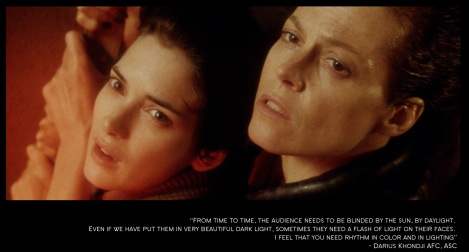 From time to time the audience needs to be blinded by the sun, by daylight. Even if we have put them in a very beautiful dark light. Sometimes they need a flash of light on their faces. I feel that you need rhythm in color and lighting.
From time to time the audience needs to be blinded by the sun, by daylight. Even if we have put them in a very beautiful dark light. Sometimes they need a flash of light on their faces. I feel that you need rhythm in color and lighting.
 From time to time the audience needs to be blinded by the sun, by daylight. Even if we have put them in a very beautiful dark light. Sometimes they need a flash of light on their faces. I feel that you need rhythm in color and lighting.
From time to time the audience needs to be blinded by the sun, by daylight. Even if we have put them in a very beautiful dark light. Sometimes they need a flash of light on their faces. I feel that you need rhythm in color and lighting.
– Darius Khondji AFC, ASC
– Harris Savides ASC
 I find the source of light for each shot and build on that. You get an artistic buzz from it. But a lot of the time it’s just working at it and doing your job.
I find the source of light for each shot and build on that. You get an artistic buzz from it. But a lot of the time it’s just working at it and doing your job.
– Adrian Biddle BSC
 It’s a bit ironic because I come from a stylised way of working but I don’t really know how to light people unless they stand next to a lamp or open a refrigerator door. I know that sounds totally insane. But, I have problems setting up lights to just light people. I approach every scene in the same way. Light comes from motivated sources and I let people fall off a lot.
It’s a bit ironic because I come from a stylised way of working but I don’t really know how to light people unless they stand next to a lamp or open a refrigerator door. I know that sounds totally insane. But, I have problems setting up lights to just light people. I approach every scene in the same way. Light comes from motivated sources and I let people fall off a lot.
– Harris Savides ASC
 I go for minimalist approach to lighting wherever I am. I try to get one or two beautiful things going on in scene and that’s enough.
I go for minimalist approach to lighting wherever I am. I try to get one or two beautiful things going on in scene and that’s enough.
– Jeffrey Kimball ASC
 I generally do not look at light as key and fill. The film stock have gotten so sensitive, one rarely needs to fill.
I generally do not look at light as key and fill. The film stock have gotten so sensitive, one rarely needs to fill.
– Harris Savides ASC
 For me, contrast is like another character in the film – a role which is played by the cinematography
For me, contrast is like another character in the film – a role which is played by the cinematography
– Darius Khondji AFC, ASC
 Always shoot soft and print contrasty. –
Always shoot soft and print contrasty. –
– Harris Savides ASC
 I love hard light in the face if it is overexposed. I think that’s beautiful. It’s different. It’s unusual. It’s exciting. It’s violent.
I love hard light in the face if it is overexposed. I think that’s beautiful. It’s different. It’s unusual. It’s exciting. It’s violent.
– Jordan Cronenweth ASC
 To me black is a very important element. Whether you’re shooting color or black and white. If you don’t have a black reference you don’t have the bottom . Especially when you are shooting black and white, you always have to have a black reference. In the frame as well as highlight reference. If you don’t have all that the grey scale in between just looks like mud.
To me black is a very important element. Whether you’re shooting color or black and white. If you don’t have a black reference you don’t have the bottom . Especially when you are shooting black and white, you always have to have a black reference. In the frame as well as highlight reference. If you don’t have all that the grey scale in between just looks like mud.
– Stephen H. Burum ASC
– Jeffrey Kimball ASC
 I think contemporary photography is going away from pretty pictures. Something that is dark is really dark, and something that is bright is very bright – the idea is to stretch photography, to make it more extreme.
I think contemporary photography is going away from pretty pictures. Something that is dark is really dark, and something that is bright is very bright – the idea is to stretch photography, to make it more extreme.
– Dariusz Wolski ASC
 [On not using fill light] It’s more dramatic and that’s what we’re chasing – maximum drama. On the wider scene in general there might be a card bounce in the front but for all practical purpose we’re not dealing with much fill. Instead we dealing with a much as four stop difference between the key in the fill, sometimes five or six stops – all the way. Whatever this film can handle, whatever the latitude of the film is, we’re right on either edge.
[On not using fill light] It’s more dramatic and that’s what we’re chasing – maximum drama. On the wider scene in general there might be a card bounce in the front but for all practical purpose we’re not dealing with much fill. Instead we dealing with a much as four stop difference between the key in the fill, sometimes five or six stops – all the way. Whatever this film can handle, whatever the latitude of the film is, we’re right on either edge.
– Jeffrey Kimball ASC
– Jordan Cronenweth ASC
 The direction of the light on characters is one of the most important elements in my work – if not the most important. The directon of the light counts more for me than its hardness or softness. Direction is what gives soul to the light and to the character. The angle can be completely frontal, which I don’t do too often, or completely backlit, rendering a silhouette. Another approach is hard three-quarter rim lighting match by a very soft side lighting from the other side. Classic side lighting is also very beautiful. There are so many variations.
The direction of the light on characters is one of the most important elements in my work – if not the most important. The directon of the light counts more for me than its hardness or softness. Direction is what gives soul to the light and to the character. The angle can be completely frontal, which I don’t do too often, or completely backlit, rendering a silhouette. Another approach is hard three-quarter rim lighting match by a very soft side lighting from the other side. Classic side lighting is also very beautiful. There are so many variations.
– Dariusz Wolski ASC
 I love backlighting not just for the sake of glamourising [the subject] but because the direction of the light can represent storytelling. I don’t do backlights and then also adds key lights and all these things – if I do backlight I want to see that backlight. That’s my style, and that’s the way we have done it in every single movie. You get criticism for the kind of lighting and you get prizes for that kind of lighting.
I love backlighting not just for the sake of glamourising [the subject] but because the direction of the light can represent storytelling. I don’t do backlights and then also adds key lights and all these things – if I do backlight I want to see that backlight. That’s my style, and that’s the way we have done it in every single movie. You get criticism for the kind of lighting and you get prizes for that kind of lighting. I can never use enough backlighting is it’s just that some director want to see the actors faces I keep telling them that the audience only goes to see sex.
I can never use enough backlighting is it’s just that some director want to see the actors faces I keep telling them that the audience only goes to see sex.
– Jordan Cronenweth ASC
 The idea of having light fall onto faces from above was inspired by the work of Gordon Willis. My light is often 2 or 2 1/2 stops underexposed. It’s very slight, and you can feel that there is something drizzling on to the faces from above. Willis did it differently – using strong light boxes overhead.
The idea of having light fall onto faces from above was inspired by the work of Gordon Willis. My light is often 2 or 2 1/2 stops underexposed. It’s very slight, and you can feel that there is something drizzling on to the faces from above. Willis did it differently – using strong light boxes overhead.
– Darius Khondji AFC, ASC
 I light through windows. I don’t surround the set in a multitude of C-stands. I try to keep a low profile.
I light through windows. I don’t surround the set in a multitude of C-stands. I try to keep a low profile.
– John Shwartzman ASC
 If you light everything through the windows, you can seldom make a wrong choice. You get natural looking contrast in the scene, and you can move a lot faster.
If you light everything through the windows, you can seldom make a wrong choice. You get natural looking contrast in the scene, and you can move a lot faster.
– David Devlin
 Our approach to lighting the room was to light it the way the light would naturally fall, and block the actors around it. We didn’t fight the natural light. We tried to enhance it. If I knew we were going to be shooting upstairs in the Alcatraz infirmary, I’d have the scissorlifts in position with either five Dinos or five Brute ARC’s, depending on the look we were going for.
Our approach to lighting the room was to light it the way the light would naturally fall, and block the actors around it. We didn’t fight the natural light. We tried to enhance it. If I knew we were going to be shooting upstairs in the Alcatraz infirmary, I’d have the scissorlifts in position with either five Dinos or five Brute ARC’s, depending on the look we were going for.
– John Shwartzman ASC
 I always soften the source. I put the source very far away and then cut it down and diffuse it, especially for close ups.
I always soften the source. I put the source very far away and then cut it down and diffuse it, especially for close ups.
– Darius Khondji AFC, ASC
 I light faces very softly and indirectly, with fluorescents. Even when the light is coming from the side, the the quality of the light is very soft. it fills. I’ll soften everything but I still need the structure of the blacks.
I light faces very softly and indirectly, with fluorescents. Even when the light is coming from the side, the the quality of the light is very soft. it fills. I’ll soften everything but I still need the structure of the blacks.
– Darius Khondji AFC, ASC
 We did a lot of lighting by putting things on the edge of the light beam – right on the fringe of the field-angle as opposed to centring the beam on the subject. We’d focus the light on the centre of the scene and then pan it left or tilt it away so that the scene was on the edge of the beam. That created a much more realistic than straight on hard light or light aimed through diffusion.
We did a lot of lighting by putting things on the edge of the light beam – right on the fringe of the field-angle as opposed to centring the beam on the subject. We’d focus the light on the centre of the scene and then pan it left or tilt it away so that the scene was on the edge of the beam. That created a much more realistic than straight on hard light or light aimed through diffusion.
– Harris Savides ASC
 My normal fill light for ambience is usually color corrected to match the shadows, to keep the scene cooler.
My normal fill light for ambience is usually color corrected to match the shadows, to keep the scene cooler.
– Darius Khondji AFC, ASC
 I don’t put a meter up and say ‘put the camera at F5 .6 A lot of the time that meter says E or there is nothing there.
I don’t put a meter up and say ‘put the camera at F5 .6 A lot of the time that meter says E or there is nothing there.
– Harris Savides ASC
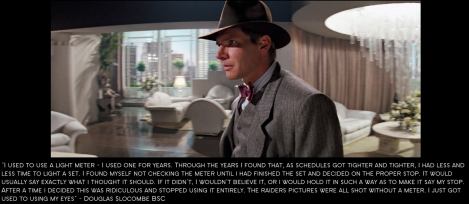 I used to use a light meter – I used one for use for years. Throughout the years I found out, as schedules got tighter and tighter, I had less and less time to light a set. I found myself not checking the meter until I had finished the set and decided on the proper stop. It would usually say exactly what I thought it should. If it didn’t, I wouldn’t believe it or I will hold it in such a way as to make it see my stop. After a time a decided this was ridiculous and stopped using it entirely. The Raiders pictures were all shot without a meter. I just got used to using my eyes.
I used to use a light meter – I used one for use for years. Throughout the years I found out, as schedules got tighter and tighter, I had less and less time to light a set. I found myself not checking the meter until I had finished the set and decided on the proper stop. It would usually say exactly what I thought it should. If it didn’t, I wouldn’t believe it or I will hold it in such a way as to make it see my stop. After a time a decided this was ridiculous and stopped using it entirely. The Raiders pictures were all shot without a meter. I just got used to using my eyes.
 I used to use a light meter – I used one for use for years. Throughout the years I found out, as schedules got tighter and tighter, I had less and less time to light a set. I found myself not checking the meter until I had finished the set and decided on the proper stop. It would usually say exactly what I thought it should. If it didn’t, I wouldn’t believe it or I will hold it in such a way as to make it see my stop. After a time a decided this was ridiculous and stopped using it entirely. The Raiders pictures were all shot without a meter. I just got used to using my eyes.
I used to use a light meter – I used one for use for years. Throughout the years I found out, as schedules got tighter and tighter, I had less and less time to light a set. I found myself not checking the meter until I had finished the set and decided on the proper stop. It would usually say exactly what I thought it should. If it didn’t, I wouldn’t believe it or I will hold it in such a way as to make it see my stop. After a time a decided this was ridiculous and stopped using it entirely. The Raiders pictures were all shot without a meter. I just got used to using my eyes.
– Douglas Slocombe BSC
 I’m always lighting to eye. I know what stop I want. I know where I want to be and I just trust my eye. I’m generally shooting around a T2 .8. I like to shoot on the wider side of things because it seems to make the image a little creamier, less punchy. Stopping down not only gives you more depth of field, it also makes the image more contrasty. Most lenses perform better at T4 or T5.6, but I like them a bit softer so I stay on the wider side.
I’m always lighting to eye. I know what stop I want. I know where I want to be and I just trust my eye. I’m generally shooting around a T2 .8. I like to shoot on the wider side of things because it seems to make the image a little creamier, less punchy. Stopping down not only gives you more depth of field, it also makes the image more contrasty. Most lenses perform better at T4 or T5.6, but I like them a bit softer so I stay on the wider side.
– Harris Savides ASC
 Over the years I’ve developed a specific lighting style, especially for day or night exteriors. I tend to put powerful sources, like a 10 K xenon, right at the edge of the frame in the background, pointing almost directly down the lens, to create a super hot edge that’s pretty off the scale stop wise. That technique always puts you in danger of getting some violent flares but if you handle it just right it adds tremendous depth to the image.
Over the years I’ve developed a specific lighting style, especially for day or night exteriors. I tend to put powerful sources, like a 10 K xenon, right at the edge of the frame in the background, pointing almost directly down the lens, to create a super hot edge that’s pretty off the scale stop wise. That technique always puts you in danger of getting some violent flares but if you handle it just right it adds tremendous depth to the image.
– Paul Cameron ASC
 This is Union Station in LA at 5:30 in the afternoon and I’m telling you there is no way to light it to look like this. This is just a Southern California sunny day with the light coming through those windows. Those windows face west you put a little bit of smoke in there. This is about picking the right time of day to shoot in turning the camera on. It looks beautiful and I’d love to take all the credits. But all I did was to have the presence of mind to say we should be shooting there in the afternoon.
This is Union Station in LA at 5:30 in the afternoon and I’m telling you there is no way to light it to look like this. This is just a Southern California sunny day with the light coming through those windows. Those windows face west you put a little bit of smoke in there. This is about picking the right time of day to shoot in turning the camera on. It looks beautiful and I’d love to take all the credits. But all I did was to have the presence of mind to say we should be shooting there in the afternoon.
– John Shwartzman ASC
 Doing good work in day exterior situation means that you must be able to make great images all day long, even when the light isn’t ideal for pretty pictures. You must make choices that will allow you to take advantage of natural light in existing conditions. Even when the light is that ‘bad’, it is possible to do good work by making wise choices. Good daytime exterior cinematography is not comprised solely of making pretty pictures at magic hour. It’s all about being knowledgeable about your craft and being able to create interesting images in all of the various daylight conditions.
Doing good work in day exterior situation means that you must be able to make great images all day long, even when the light isn’t ideal for pretty pictures. You must make choices that will allow you to take advantage of natural light in existing conditions. Even when the light is that ‘bad’, it is possible to do good work by making wise choices. Good daytime exterior cinematography is not comprised solely of making pretty pictures at magic hour. It’s all about being knowledgeable about your craft and being able to create interesting images in all of the various daylight conditions.
– John Toll ASC
 Dougie more than any cameraman I’ve worked with uses the sun as a key light and let’s essentially everything follow its rout. Really for the first time I became aware of how the sun could be used as a tool of great artistry and I think Slocombe used the sun on Raiders the way Vittorio Storraro uses his amber smokey units inside to such great effect.
Dougie more than any cameraman I’ve worked with uses the sun as a key light and let’s essentially everything follow its rout. Really for the first time I became aware of how the sun could be used as a tool of great artistry and I think Slocombe used the sun on Raiders the way Vittorio Storraro uses his amber smokey units inside to such great effect.
– Steven Spielberg
 More and more, I just prefer to use the real daylight. I use the skylight as a top light, then negative fill to create contrast. For me this is much more effective than using artificial light.
More and more, I just prefer to use the real daylight. I use the skylight as a top light, then negative fill to create contrast. For me this is much more effective than using artificial light.
– Darius Khondji AFC, ASC
 Some people hate flares and some people love them. I tend to fall in the Jan De Bont ASC school. I find them interesting and beautiful depending on the source of light giving you the flare. I like to use flares to transition in or out of a scene, or to heighten the sense of energy in a shot. It’s something to be used as a tool.
Some people hate flares and some people love them. I tend to fall in the Jan De Bont ASC school. I find them interesting and beautiful depending on the source of light giving you the flare. I like to use flares to transition in or out of a scene, or to heighten the sense of energy in a shot. It’s something to be used as a tool.
– John Shwartzman ASC
 Kino Flo’s are one of the best lights, and one of my favourites. However, Kino’s have such unnaturally glamorous quality that they sometimes give off too nice a glow. In some movies you can feel that the actors are lit with Kino’s and I try to avoid that. You have to be careful to gave those lights grit, some realness. You have to put things between Kino’s and the faces, or put the Kino’s at an edgy angle so they look as if they are naturally surrounding the actors.
Kino Flo’s are one of the best lights, and one of my favourites. However, Kino’s have such unnaturally glamorous quality that they sometimes give off too nice a glow. In some movies you can feel that the actors are lit with Kino’s and I try to avoid that. You have to be careful to gave those lights grit, some realness. You have to put things between Kino’s and the faces, or put the Kino’s at an edgy angle so they look as if they are naturally surrounding the actors.
– Darius Khondji AFC, ASC
 Candles were part of our lighting on all three movies. On the first film we asked the art department for three week candles so we’d get the maximum flame and output. On any set that was a night interior we’d try use as much candlelight as possible. We even use them for fill, putting six or eight of them on stands – it’s the most realistic flicker effect you’re going to get. Above the room, we had soft boxes color corrected to match the firelight for fill. We used Kino Flo’s – some 4-BYs and some we made from Kino Flo parts. Darius had an idea to build a loose fixture with fabric that we could just wrap around parts of the set like posts.
Candles were part of our lighting on all three movies. On the first film we asked the art department for three week candles so we’d get the maximum flame and output. On any set that was a night interior we’d try use as much candlelight as possible. We even use them for fill, putting six or eight of them on stands – it’s the most realistic flicker effect you’re going to get. Above the room, we had soft boxes color corrected to match the firelight for fill. We used Kino Flo’s – some 4-BYs and some we made from Kino Flo parts. Darius had an idea to build a loose fixture with fabric that we could just wrap around parts of the set like posts.
– Rafael Sanchez
 [Adrian Biddle] uses a faint layer of smoke. He uses a lot of soft light and he gives everything a creamy look. It’s not so much smoky it has a light texture and it’s very nice to look at.
[Adrian Biddle] uses a faint layer of smoke. He uses a lot of soft light and he gives everything a creamy look. It’s not so much smoky it has a light texture and it’s very nice to look at.
– Jonathan Taylor
 Naturally to create shafts of light one must have some medium. Smoke is wonderful photographically but not without its problems. The only practical way to judge smoke density is by eye. I found a good density is achieved just before I lose consciousness.
Naturally to create shafts of light one must have some medium. Smoke is wonderful photographically but not without its problems. The only practical way to judge smoke density is by eye. I found a good density is achieved just before I lose consciousness.
– Jordan Cronenweth ASC
 Smoke is just another tool that you use at will. When I think it’s appropriate, I use it. It’ll always add another layer of depth to what you’re doing, inside or outside. I have nearly poisoned myself with different smoke experiments and I feel I have pretty good control over now. You photograph only about 50% of what you see with your eyes depending on what degree of backlight there is.
Smoke is just another tool that you use at will. When I think it’s appropriate, I use it. It’ll always add another layer of depth to what you’re doing, inside or outside. I have nearly poisoned myself with different smoke experiments and I feel I have pretty good control over now. You photograph only about 50% of what you see with your eyes depending on what degree of backlight there is.
– Jeffrey Kimball ASC
One of the exterior was in the jungle clearing where Steven and I wanted to make use of the rays of sunshine coming through the trees, which is always a cameraman’s dream. Of course one puts down smoke, so the rays light up the smoke. But, the schedule didn’t really enable one to hang around too long, and I had to try and reproduce this with ARC lights rather than waiting for the sun to shine through the trees.
– Douglas Slocombe BSC
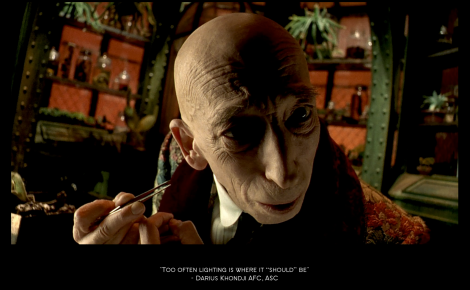
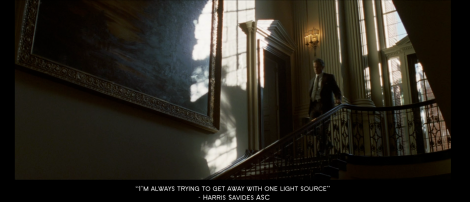
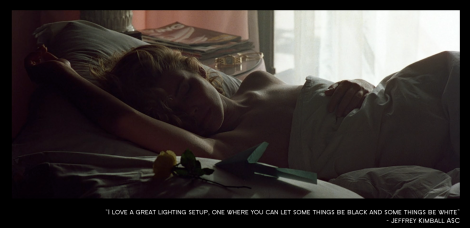
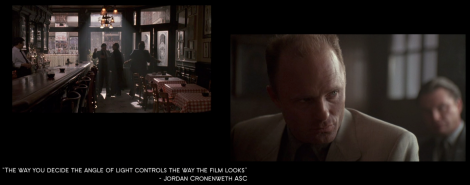
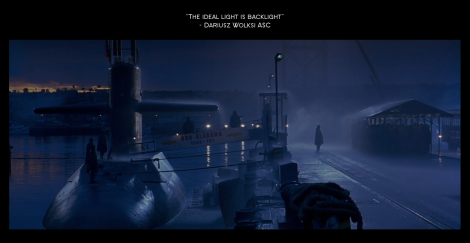
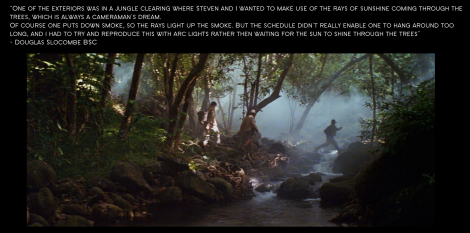


Yorumlar
Yorum Gönder